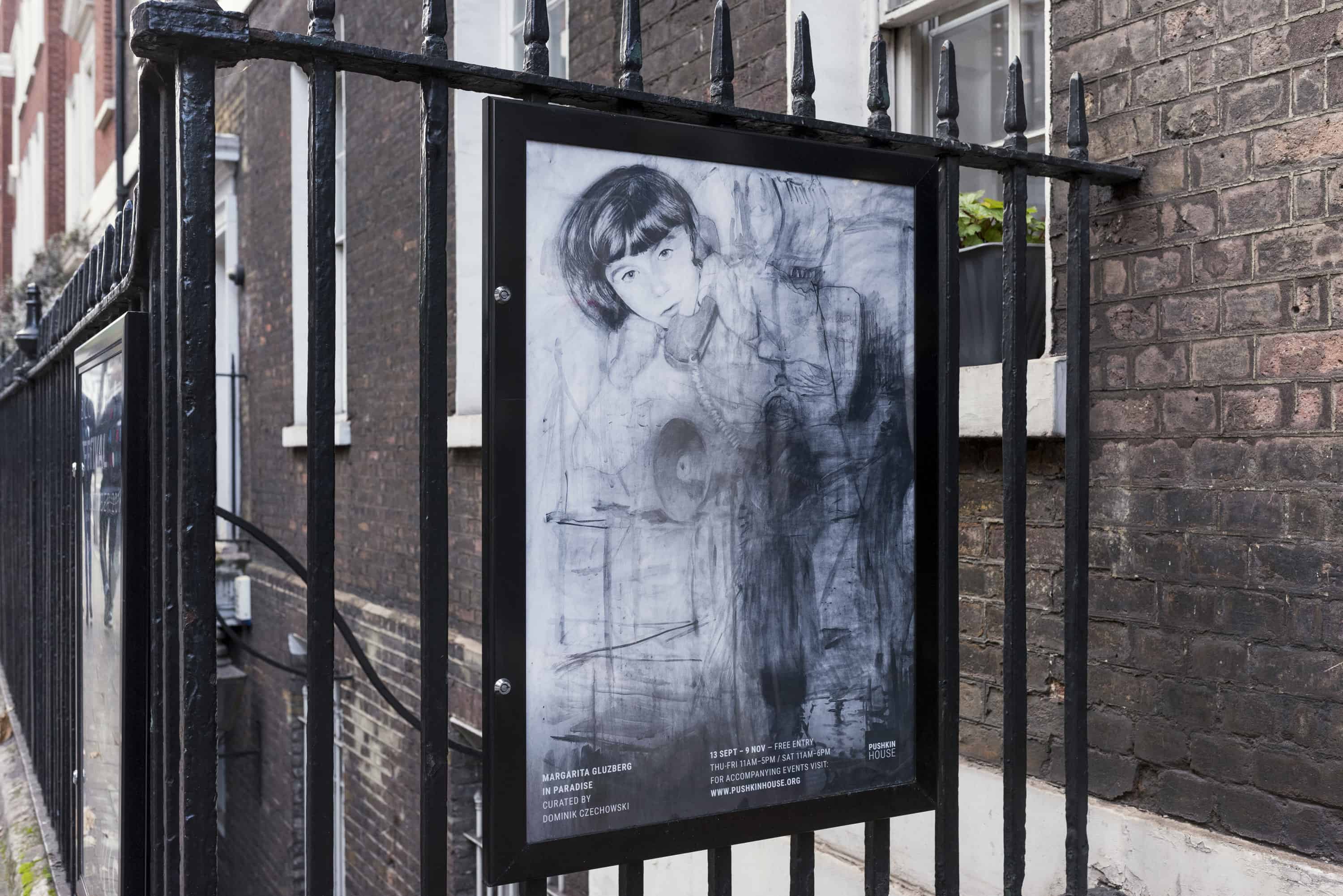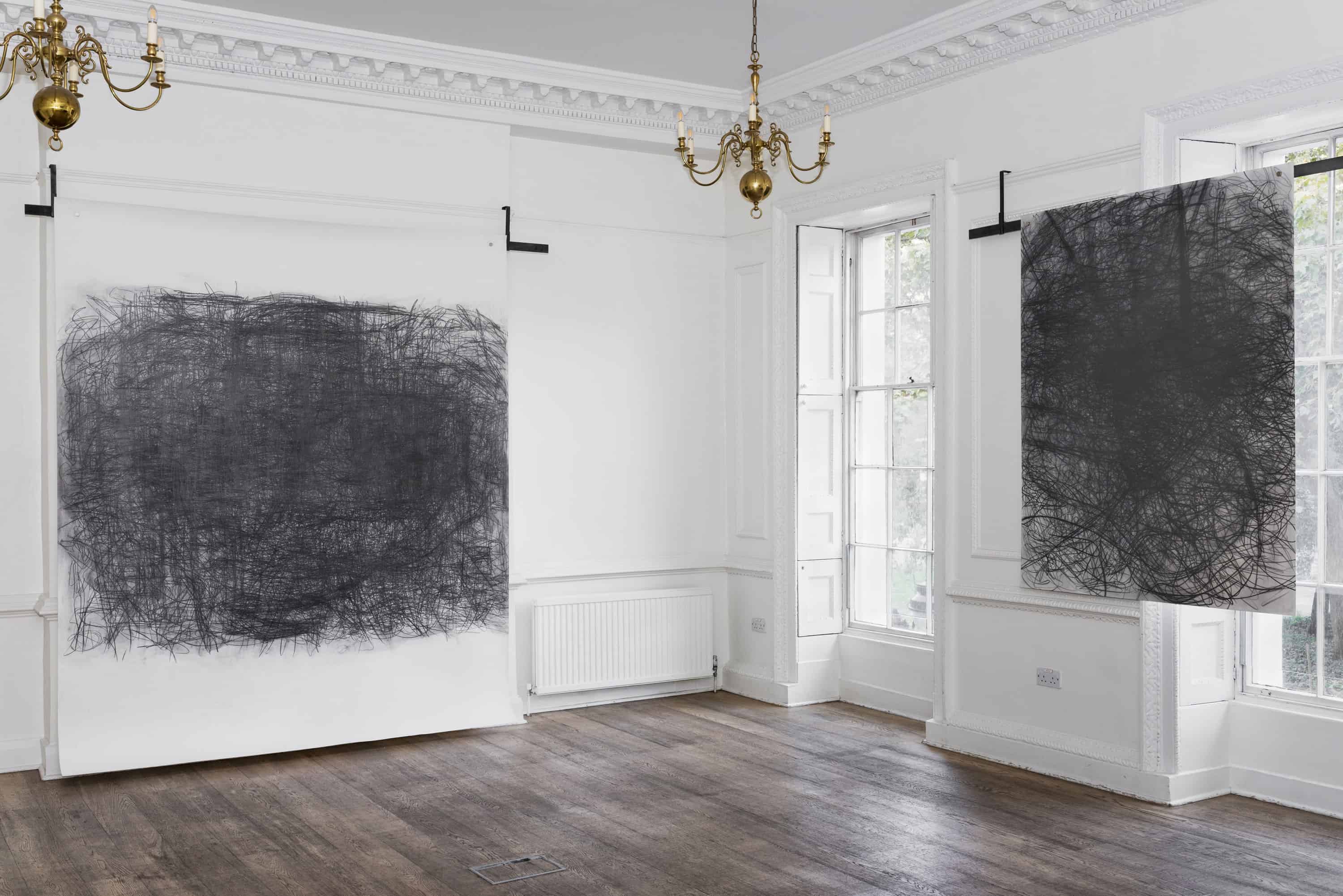“He wrote me: one day I’ll have to put it all alone at the beginning of a film with a long piece of black leader;
if they don’t see happiness in the picture, at least they’ll see the black.”
— Chris Marker, Sans Soleil
Margarita Gluzberg’s work often explores the tensions and reciprocal interplay between the past and the present, memory recall and recurring fiction, and the politics of desire. She is fascinated with surface reality and material manifestations of consumer culture, and has a multi-faceted approach to image-making and production of meaning. Her practice, ranging from drawing, photography and performance to sound and film installation, draws upon historical events, semi-biographical stories, and eclectic cultural references to create visually charged environments that summon memories of the past and negotiate aspects of contemporary existence.

Margarita Gluzberg, “In Paradise” exhibition, Pushkin House, London, courtesy of the artist. Photo: Thierry Bal
2019 marked 40 years since Andrei Tarkovsky’s classic sci-fi drama ‘Stalker’ was made, and also 40 years since Gluzberg left Russia as a young girl. ‘Stalker’ remains a radically current film touching on major cultural and existential themes such as environmental politics and spiritual crisis. This dystopian travelogue about a journey of three men (the eponymous Stalker, the Writer, and the Professor) through the restricted Zone to the infamous Room that can grant any wish, strangely and metaphorically resonates with the artist’s personal experience. When Gluzberg left Moscow in 1979 to move to England, the ‘West’ itself represented a forbidden zone that held infinite promise.
In Paradise was a site-specific exhibition at the Pushkin House in London that featured a new series of large-scale drawings occupying the central space of the House, which the artist calls ‘cinema experiments’. Made during the night, these were constructed by projecting ‘Stalker’ directly onto sheets of paper and ‘recording’ the moving image in real time as pencil marks. Different parts of the film were focused on, and what emerged were complex abstract works that meditated on the film’s structure and became visual testimony to the artist’s own emotional/inner landscapes in the action of making.

Margarita Gluzberg, “In Paradise” exhibition, Pushkin House, London, courtesy of the artist. Photo: Thierry Bal
Interacting with the Georgian townhouse interior, Gluzberg used hand-made metal bars to hang the drawings so they formed a unique mise-en-scene – a set of concepts for visitors-actors to engage with. The drawings thus became the backdrop for imaginary projection of the viewer’s own thoughts, a visual topography that might triggers formation of subjective mental maps. Through their physical substance and intensity of gesture, the pieces created a spatial disorientation, pointing to the possibilities of drawing as a sculptural act. Mesh networks of lines and marks of chance encounters and collisions, these huge ‘silver screens’ were the record of philosophical and personal ruminations between the main characters in ‘Stalker’. Although each drawing had its own agency and could structure our actions or influence thought processes, they all carried suggestions of purpose and intention. They came to be containers for our own thinking and dreaming.
Despite their hyper-trance and fragmentary nature, the works corresponded with Tarkovsky’s philosophical odyssey in its focus towards the Aristotelian dramatic unities of time, space, and action. Gluzberg’s drawings were the result of nocturnal activity in her studio – an anatomy of silence and memory at work, and an act of documentation rather than creativity or imagination. They related to the famous colour sequence of the film – the fantastical Zone and the characters traversing its abandoned post industrial wilderness. By layering lines of graphite to record the peripheries around human presence on the screen – the forest, the water, the sky – Gluzberg’s monochromatic works turned into eerie ‘landscape paintings’ that demanded human company.

Margarita Gluzberg, “In Paradise” exhibition, Pushkin House, London, courtesy of the artist. Photo: Thierry Bal
These new works were accompanied by recent drawings across the various spaces of Pushkin House that reconfigured trajectories of ‘Stalker’ through biographical subjects of migration, childhood, cultural memory and aspiration. Here, the artist recruited a diverse cast of characters from Soviet cartoons and her own life to become ‘guides’ (stalkers) for the visitors on their journey to and through the ‘Zone’. The enormous drawing of the iconic Cheburashka – a furry mascot friend with large ears as big as its head – greeted visitors upon entering the House. Cheburashka in that context symbolised a precursory champion to the luxury goods West that Gluzberg had once desired. That, and other drawings of children, animals and fictional creatures from animated TV series indexed completely different formal language that evoked the iconography of the late 70s Russian culture, now reachable through the technologically aided memory – the Internet, films, and photographs.
All these characters attempted at communication, though they also hinted at the highly reconstructive, frivolous and ambiguous nature of human recollection. They facilitated the artist’s own endeavour to access the past, her personal quest for reunion, but also a closure. Excerpted arbitrarily from the vast visual repertoire of Gluzberg’s life, they were all protagonists that ‘re-populate’ the Zone, a multi-dimensional territory that had the potential to be anything we want – and in this case, the framework for making art. Besides, just like in the movies, the most important part came from the experience that the characters, and the audience, went through together.
Written by Dominik Czechowski
London based curator and writer
The solo exhibition by Margarita Gluzberg took place at Pushkin House in London, between 12 September and 10 November 2019
Margarita Gluzberg, “In Paradise” exhibition, Pushkin House, London, courtesy of the artist. Photo: Thierry Bal
Margarita Gluzberg, “In Paradise” exhibition, Pushkin House, London, courtesy of the artist. Photo: Thierry Bal
Artist biography
Born in Moscow, Margarita Gluzberg has lived in London since 1979. Over the last two decades, her work has been presented at major contemporary art spaces that include the MAC/VAL, Paris; CAC, Vilnius; Rooseum, Malmö; KAdE Kunsthal, The Netherlands; Lunds Konsthall, Lund; British School, Rome (where she was a Wingate Scholar); Drawing Room, London; and most recently Site Gallery, Sheffield. In 2016 her Wellcome Trust project ‘Rock On Bones’, a series of multi-media Performance Lectures, was staged at the De La Warr Pavilion, Bexhill; Performance Studio, London; and the Royal College of Art.
Gluzberg has had an extensive teaching career – most recently the RCA, where she was Reader in Contemporary Visual Production for many years. She became Senior Lecturer at the Royal Academy Schools in 2018.
Margarita Gluzberg, “In Paradise” exhibition, Pushkin House, London, courtesy of the artist. Photo: Thierry Bal








